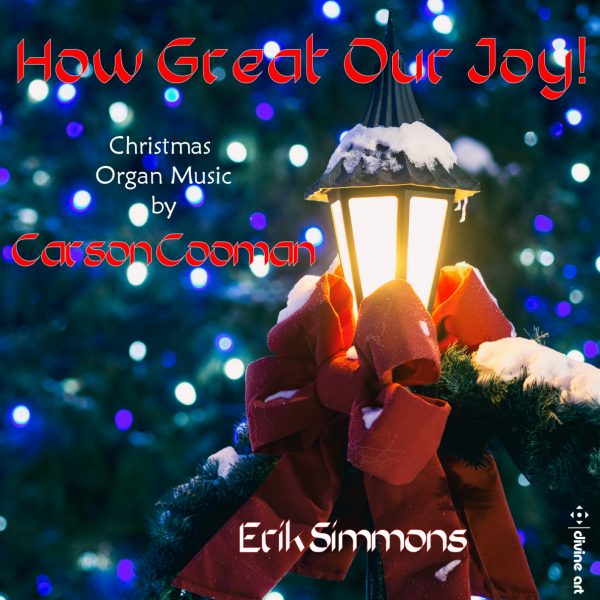American Record Guide
American composer Carson Cooman (b 1982) is extraordinarily prolific. The Fantasy on ‘Adeste Fideles’ (2018) that concludes this recording is his Opus 1322. This disc is part of a series devoted to his organ works in performances by Erik Simmons. The booklet contains advertisements for 11 other recordings in the series. According to the booklet notes, works by Cooman have appeared in more than 40 recordings on various labels. He is himself an accomplished concert organist specializing in contemporary music, and more than 100 composers have written over 300 pieces especially for him.
Here we have short organ pieces based on Christmas hymns and carols. Some are commissions and others were written as gifts for the composer’s friends. Two pieces were written in 2004; the rest date from 2013 to 2018. The style is modern but accessible, even when crunchy dissonance is involved. The expressive range is wide, from the wistful tenderness of the Little Partita on the Polish carol ‘Infant Holy, Infant Lowly’ (2013) and the mysterious quietness of the Meditation on ‘Es ist ein Ros’ (2018) to the bombast of the Voluntary on ‘O du Fröhliche’ (2018) and the Fantasy on ‘Adeste Fideles’.
It is hardly surprising that there is a strong family resemblance among Cooman’s pieces, even with their breadth of expression. With such a huge output it is to be expected that he sometimes repeats himself. If you have heard one of his fanfare introductions, you’ve heard them all. His treatment of the carol melodies is varied. Sometimes he will allow a tune to unfold in full, often with unexpected harmonies or rhythmic alterations. Elsewhere he may use fragments of the tune for thematic development. Sometimes the melody is heavily disguised, as in the Meditation on ‘Es ist ein Ros’. The backdrop in this piece is a sequence of sustained, quiet chords of rich harmony. A solo line embeds the familiar melody in a melodic elaboration that goes well beyond what Brahms did with the same tune.
I confess that this is my first serious acquaintance with Cooman’s music. My initial impression was that this is music marked by highly imaginative touches but not the stuff of greatness. Subsequent hearings and the writing of colleagues suggest that there is more to him than that. To be fair, this recording consists entirely of short pieces, offering little opportunity to gauge the composer’s capacity for larger musical architecture. He has written larger-scale instrumental works and operas. Robert Delcamp spoke highly of earlier releases in the organ series. My friend James Altena, who writes for a competing publication, has declared Cooman “not just a talented composer but a genuinely gifted one” The organ is at the Church of SS Peter and Paul in Gorlitz, Germany. It was built by the Swiss firm of Mathis in 1997 with a swell division added in 2006. The instrument is grounded in the baroque tradition but is large and eclectic enough to play a wide range of repertory convincingly. It is important to note that the instrument was not recorded directly but by means of the Hauptwerk system. In that system, each pipe of an instrument is recorded several times with different key velocities for attack and release. The reverberant decay of the tone is also recorded to capture the acoustical properties of the room. The data is loaded into the memory of a computer, and when connected to an appropriate organ console, the organist is in effect able to play the organ that has been so recorded. The effect here is quite impressive.
@divineartrecordingsgroup
A First Inversion Company
Registered Office:
176-178 Pontefract Road, Cudworth, Barnsley S72 8BE
+44 1226 596703
Fort Worth, TX 76110
+1.682.233.4978








![Listen to the full suite of Marcel Dupré’s Variations Sur un Noël, Op. 20 from Alexander Ffinch’s #Expectations release today! listn.fm/expectations [in bio]](https://scontent-dfw5-1.cdninstagram.com/v/t51.71878-15/588904367_2327488161082898_8709236950834211856_n.jpg?stp=dst-jpg_e35_tt6&_nc_cat=105&ccb=7-5&_nc_sid=18de74&efg=eyJlZmdfdGFnIjoiQ0xJUFMuYmVzdF9pbWFnZV91cmxnZW4uQzMifQ%3D%3D&_nc_ohc=v_eEWMfBei4Q7kNvwGgEKqs&_nc_oc=AdmWTAx0BY8qqa3x6XpAH9ZjD6bXRFYLjPtv6paHrc_lwfcy-uxXZqemRxPGJKXucfo&_nc_zt=23&_nc_ht=scontent-dfw5-1.cdninstagram.com&edm=ANo9K5cEAAAA&_nc_gid=MjQumDpkwi__00KDL3q5bg&oh=00_AfnjWZQEJNGLSYTx3_fr6PTItff0JPW8mlzcEK-E1leQMw&oe=694A6CAA)

![“the ‘Manteca’ Paraphrase – a rare foray into the two-piano medium but here played double-tracked – exudes a panache of which Dizzy Gillespie would surely have approved.… [a] recital well worth investigating.” —Gramophone Magazine with high praise for Ophelia Gordon's debut release, Kapustin: Between the Lines!](https://scontent-dfw5-3.cdninstagram.com/v/t51.82787-15/598796470_18303255136283342_540941604740887837_n.jpg?stp=dst-jpg_e35_tt6&_nc_cat=108&ccb=7-5&_nc_sid=18de74&efg=eyJlZmdfdGFnIjoiRkVFRC5iZXN0X2ltYWdlX3VybGdlbi5DMyJ9&_nc_ohc=sFsWUr2jc5wQ7kNvwFLG4Ip&_nc_oc=Adn4sWWId4YXuTrVF_p4sX-hsJ-pzRSx9PL36ufdfesCIy7FLwbFpBkEjQeRYPnSrW8&_nc_zt=23&_nc_ht=scontent-dfw5-3.cdninstagram.com&edm=ANo9K5cEAAAA&_nc_gid=MjQumDpkwi__00KDL3q5bg&oh=00_Afki4RLbMoAwPZmVVzQf7RwQhKEO52GfbRuiij8G4K5kdA&oe=694A7F44)

